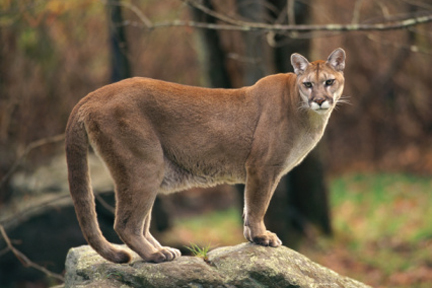I’ve recently heard rumors around the camp that there has been a mountain lion making its way onto our territory. My intrigue toward cats in the puma family has been on a shelf since leaving the gulf coast behind and with it my tedious efforts towards catching a glimpse of the highly endangered Florida Panther. These felines are elusive, stealthy, and hardly ever make themselves known unless somehow caught off guard. So imagine my surprise, whilst walking along the south bank of Jenks Lake, when one of the teachers along for the hike spoke mention of a large animal track we p assed a few hundred feet back. “A black bear,” I offered as she spoke of the size. “Nope, a cat for sure, you know how you can’t see their claws?” she replied. My mind flew back to the stories of my fellow camp instructors and my eyes fell to the ground in hopes to discover more proof. Not one minute later was my excitement peeked. On the same path I was walking at that very moment, a mountain lion had recently sauntered down as well. The paw print unmistakable, the size of which remarkable, I couldn’t believe my eyes.
assed a few hundred feet back. “A black bear,” I offered as she spoke of the size. “Nope, a cat for sure, you know how you can’t see their claws?” she replied. My mind flew back to the stories of my fellow camp instructors and my eyes fell to the ground in hopes to discover more proof. Not one minute later was my excitement peeked. On the same path I was walking at that very moment, a mountain lion had recently sauntered down as well. The paw print unmistakable, the size of which remarkable, I couldn’t believe my eyes.
Puma concolor (common names including panther, cougar, mountain cat and puma), is one of the most widely distributed mammals in North America, but due to its territorial manner, exist only in pocketed low density populations throughout its range. Weighing between 100-230lbs, this golden brown cat is a fierce predator, stalking mostly deer along the rocky edges, open valleys or dense underbrush of the San Bernardino Mountains. As an ambush hunter, the mountain lion will generally sneak up on its prey, use its huge paws to tackle the animal to the ground and then its powerful jaw to snap its neck. Mountain lions being solitary and secretive are a crepuscular species, mostly active at dawn and dusk, but moving throughout the night. Depending on suitable habitats and prey availability, one adult male’s range can be from 10-200 square miles. Judging by the size of the print left along the snow laden path of Jenks Lake, there was a very large male in the area and only a female mountain lion would be silly enough to cross his path.
Although mating season can occur year round, females will generally overlap a males territory for reproduction between December and March. A litter of one to six cubs is often had every one to three years and gestation lasts about 3 months. When the cubs are born, they have bright blue eyes and black spots atop their golden orange fur. Female cougars are very protective of their young, but when maturity is reached between 1 1/2- 3 years, the cubs are left to fend for themselves and find their own territory. With a lifespan averaging 12 years, it is likely a cub born in these mountains will travel hundreds of miles away to stake it’s claim in a different area and never visit its birthplace again.
The cougar is an animal that demands respect as an important part of our environment and an integral piece to its balance as a means of controlling prey populations. Almost the size of a full grown human, the mountain lion’s biggest threat is man and the impacts we have on its environment. Even though I probably won’t ever get the chance to see the elusive mountain lion of Jenks Lake, at least I know he is there and I can only hope that he is thriving. Don’t be too frightened; kids and instructors alike should have no fear of running into a mountain lion up here. Not only are they secretive and rare, they can hear us coming from far away and try their best to stay clear of loud and crazy humans.

Comments are closed.